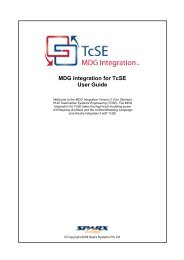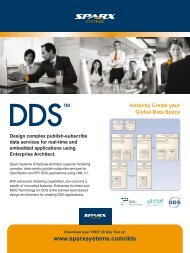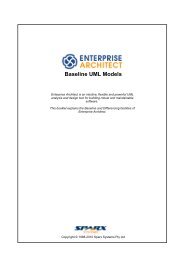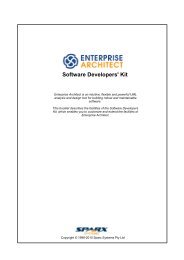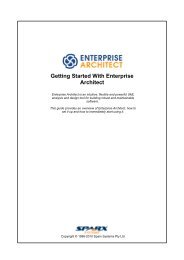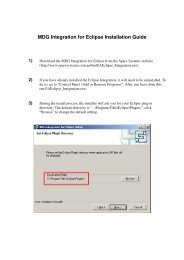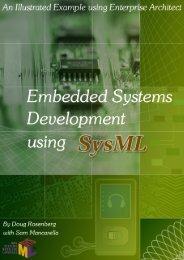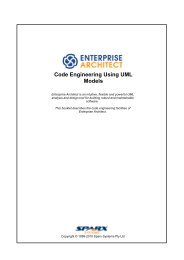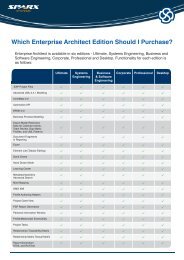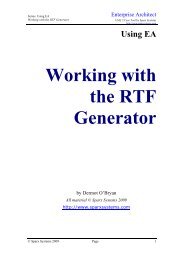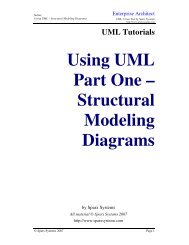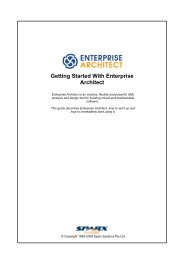Version Control Best Practices for Enterprise Architect
Version Control Best Practices for Enterprise Architect
Version Control Best Practices for Enterprise Architect
Create successful ePaper yourself
Turn your PDF publications into a flip-book with our unique Google optimized e-Paper software.
<strong>Version</strong> <strong>Control</strong> <strong>Best</strong> <strong>Practices</strong> <strong>for</strong><br />
<strong>Enterprise</strong> <strong>Architect</strong><br />
www.sparxsystems.com<br />
All Material © Sparx Systems, 2010
Table of Contents<br />
Glossary................................................................................................................................................3<br />
Introduction..........................................................................................................................................4<br />
Why Should I consider version controlled models?........................................................................4<br />
What does 'version control' mean in <strong>Enterprise</strong> <strong>Architect</strong>?.............................................................4<br />
Team Deployment: Centralized or Distributed....................................................................................5<br />
Scenario 1: Centralized Team..............................................................................................................6<br />
Recommended process <strong>for</strong> version controlling models...................................................................7<br />
Recommended process <strong>for</strong> rolling back (undoing) changes............................................................8<br />
Scenario 2: Distributed Team using local models................................................................................8<br />
Recommended process <strong>for</strong> version controlling models...................................................................9<br />
Managing cross-Package dependencies...........................................................................................9<br />
Recommended processes <strong>for</strong> submitting changes safely...............................................................10<br />
Recommended process <strong>for</strong> rolling back (undoing) changes..........................................................14<br />
Scenario 3: Multiple Site Locations...................................................................................................15<br />
Appendix A: <strong>Enterprise</strong> <strong>Architect</strong> meta-data that is not stored in the <strong>Version</strong> <strong>Control</strong> Repository.. 16<br />
Appendix B: Built-in Collaboration and Change Management Tools...............................................16<br />
Appendix C: Applying <strong>Version</strong> <strong>Control</strong> to Packages.........................................................................17<br />
2
Glossary<br />
Baseline (Model Baseline): In <strong>Enterprise</strong> <strong>Architect</strong>, a Baseline refers to a snapshot of a Package at a particular point in<br />
time. The snapshot is stored in the Model Repository as compressed XMI and <strong>for</strong>ms the basis of <strong>Enterprise</strong> <strong>Architect</strong>'s<br />
Compare and Merge functionality.<br />
Check-in: The process of submitting your changes to the <strong>Version</strong> <strong>Control</strong> Repository. In <strong>Enterprise</strong> <strong>Architect</strong>, you<br />
execute this command on a Package that you have checked out. This then updates the <strong>Version</strong> <strong>Control</strong> Repository with<br />
your changes and releases your editing lock on that Package.<br />
Check-out: The process of retrieving the latest version of a file from the <strong>Version</strong> <strong>Control</strong> Repository. Executing this<br />
command from <strong>Enterprise</strong> <strong>Architect</strong> will overwrite the selected Package with the latest version and lock that Package<br />
<strong>for</strong> your exclusive editing.<br />
Commit: Submit your changes to the <strong>Version</strong> <strong>Control</strong> Repository without releasing your editing lock on the related<br />
file(s). In <strong>Enterprise</strong> <strong>Architect</strong>, this is equivalent to executing the “Put Latest” command.<br />
DBMS: Database Management System. <strong>Enterprise</strong> <strong>Architect</strong> supports several relational DBMS products to host the<br />
Model Repository. A DBMS is commonly used when the Model Repository is accessed by several concurrent users.<br />
EAP: <strong>Enterprise</strong> <strong>Architect</strong> Project. The abbreviation usually refers to the file-based Model Repository, hence 'EAP file.'<br />
Get Latest: A command executed from within <strong>Enterprise</strong> <strong>Architect</strong> on a selected Package. Updates that Package with<br />
the latest in<strong>for</strong>mation from the <strong>Version</strong> <strong>Control</strong> Repository, without per<strong>for</strong>ming a Check-out. Get All Latest updates all<br />
version controlled Packages in the project.<br />
Model Repository: <strong>Enterprise</strong> <strong>Architect</strong>'s storage mechanism <strong>for</strong> model in<strong>for</strong>mation. If multiple users concurrently edit<br />
the same model, the repository is usually DBMS-based. In distributed team environments where concurrent model<br />
access is not possible, local EAP files are usually deployed instead.<br />
<strong>Enterprise</strong> <strong>Architect</strong> can use your <strong>Version</strong> <strong>Control</strong> System to transfer in<strong>for</strong>mation between the Model Repository and a<br />
<strong>Version</strong> <strong>Control</strong> Repository to propagate changes amongst team members.<br />
Package: The primary organizational construct in <strong>Enterprise</strong> <strong>Architect</strong> models, roughly equivalent to a 'folder' in the<br />
file system. A Package may be a model's Root node, a View or a sub-Package.<br />
Put Latest: A command executed from within <strong>Enterprise</strong> <strong>Architect</strong> on a selected Package that you have checked out.<br />
Updates the <strong>Version</strong> <strong>Control</strong> Repository with your changes to that Package, while retaining its 'Checked-out' status.<br />
(Equivalent to checking a Package in and immediately checking it back out again.)<br />
<strong>Version</strong> <strong>Control</strong> Configuration: In <strong>Enterprise</strong> <strong>Architect</strong>, a <strong>Version</strong> <strong>Control</strong> Configuration records connection settings<br />
<strong>for</strong> the <strong>Version</strong> <strong>Control</strong> Repository and the path to your local Working Copy.<br />
<strong>Version</strong> <strong>Control</strong> Repository: The storage mechanism used by the <strong>Version</strong> <strong>Control</strong> System to store revisions –<br />
specifically, model revisions.<br />
<strong>Version</strong> <strong>Control</strong> System: The third-party product that manages revisions of your model data. <strong>Enterprise</strong> <strong>Architect</strong><br />
supports several <strong>Version</strong> <strong>Control</strong> Systems (such as CVS, Subversion and SCC-compliant products) and provides the<br />
user interface needed to move data between the Model Repository and the <strong>Version</strong> <strong>Control</strong> Repository.<br />
Working Copy: The set of files on your local machine that you have retrieved from the <strong>Version</strong> <strong>Control</strong> Repository.<br />
<strong>Enterprise</strong> <strong>Architect</strong> uses your working copy files to update the Model and <strong>Version</strong> <strong>Control</strong> Repositories.<br />
XMI: XML Meta-data Interchange. An open standard file <strong>for</strong>mat that enables the interchange of model in<strong>for</strong>mation<br />
between tools. <strong>Enterprise</strong> <strong>Architect</strong> uses this file <strong>for</strong>mat to serialize a Package's model in<strong>for</strong>mation to facilitate storage<br />
in the <strong>Version</strong> <strong>Control</strong> Repository. When you apply version control to a Package in <strong>Enterprise</strong> <strong>Architect</strong>, one XMI file<br />
is created <strong>for</strong> that Package (and its contained elements) and added to the <strong>Version</strong> <strong>Control</strong> Repository.<br />
3
Introduction<br />
This document explains how version control concepts apply to Sparx Systems <strong>Enterprise</strong> <strong>Architect</strong> and suggests best<br />
practices <strong>for</strong> establishing version control in shared and distributed modeling environments. The in<strong>for</strong>mation presented<br />
here is intended <strong>for</strong> <strong>Enterprise</strong> <strong>Architect</strong> users who:<br />
• Want to know whether applying version control to their model could be beneficial and what alternatives are<br />
available or;<br />
• Require best practice advice <strong>for</strong> specific <strong>Enterprise</strong> <strong>Architect</strong> deployment scenarios or;<br />
• Already have experience with version controlled models and wish to improve how these are managed.<br />
Why Should I consider version controlled models?<br />
In general, benefits of using version control systems include: increasing the potential <strong>for</strong> parallel and distributed work,<br />
improved ability to track and merge changes over time and automating management of revision history. Following are<br />
some specific benefits that can be realized by applying version control to a modeling environment. These are most<br />
relevant when models are shared by multiple editors, who may also be geographically dispersed:<br />
• Supports globally distributed model editing by providing a convenient and effective way of replicating models.<br />
• Facilitates collaboration across multiple projects through re-use of common model data.<br />
• Improves per<strong>for</strong>mance <strong>for</strong> widely dispersed teams over slow networks by allowing local storage of models,<br />
with global propagation of changes only.<br />
• Promotes orderly changes over chaotic changes and helps to minimize disruptions by separating "work in<br />
progress" from "finished" work.<br />
• Helps automate communication within a team by coordinating 'edit' access to controlled in<strong>for</strong>mation, thereby<br />
preventing accidental modification.<br />
• Helps maintain successive revisions of work-to-date with the ability to "undo" changes that are not required,<br />
"roll back" to the last "good" version to undo a mistake, or recover from accidental deletions or changes.<br />
• Maintains a work history and audit trail of changes to a model, helping to answer 'Who changed what and<br />
when?'<br />
What does 'version control' mean in<br />
<strong>Enterprise</strong> <strong>Architect</strong>?<br />
<strong>Enterprise</strong> <strong>Architect</strong> applies version control to Packages<br />
within a model. A Package is the primary organizational<br />
construct <strong>for</strong> UML models. Any Package may have version<br />
control applied to it - whether it is the model's Root node, a<br />
View or a sub-Package (see Figure 1).<br />
<strong>Enterprise</strong> <strong>Architect</strong> supports two primary ways of version<br />
controlling Packages in a model:<br />
1. Model Baselines: This built-in capability, stores<br />
point-in-time snapshots of a Package in the model<br />
repository itself. The Model Baselines concept also<br />
<strong>for</strong>ms the basis of <strong>Enterprise</strong> <strong>Architect</strong>'s 'compare<br />
and merge' facility.<br />
Figure 1: <strong>Version</strong> <strong>Control</strong> at the Root, View, Package or Sub-Package<br />
When deciding on approaches to version control,<br />
strong consideration should be given to the use of Model Baselines, especially where the need is essentially to<br />
maintain a revision history <strong>for</strong> purposes of comparison, merge and roll-back.<br />
2. <strong>Version</strong> <strong>Control</strong> Integration: <strong>Enterprise</strong> <strong>Architect</strong> supports integration with third-party version control<br />
systems, allowing users to store Package revisions in their preferred tool. <strong>Version</strong> control tools supported by<br />
<strong>Enterprise</strong> <strong>Architect</strong> include Subversion, CVS, Microsoft's TFS and SCC compatible tools, such as Accurev<br />
and Visual Source Safe.<br />
For large, distributed teams it is often necessary to use such a dedicated version control system to manage<br />
broad-scale replication and sharing of model data.<br />
4
This document focuses on the latter approach – achieving version control with third-party integrated tools. Readers who<br />
are interested in related change management features and simple alternatives, should refer to Appendix B: Built-in<br />
Collaboration and Change Management Tools<br />
Figure 2 provides a high-level schematic of the relationship between <strong>Enterprise</strong> <strong>Architect</strong> and the external version<br />
control system. Note that versions are stored and retrieved as XMI files. XMI is used to serialize Package in<strong>for</strong>mation to<br />
create a point-in-time snapshot. <strong>Enterprise</strong> <strong>Architect</strong> en<strong>for</strong>ces that only a single user edits a given Package at once. This<br />
approach represents a “Lock-Modify-Unlock” solution, which helps to avoid revision conflicts – especially useful as<br />
XMI files are considered binary artifacts that cannot be merged directly via the <strong>Version</strong> <strong>Control</strong> System.<br />
deployment Interfaces<br />
<strong>Version</strong> <strong>Control</strong><br />
System<br />
The rest of this document is designed to help you identify your deployment scenario <strong>for</strong> <strong>Enterprise</strong> <strong>Architect</strong> and to<br />
suggest suitable version control approaches. For each approach, we also highlight specific challenges that need to be<br />
addressed. Instead of providing detailed “how-to” steps <strong>for</strong> setting up your version control system with <strong>Enterprise</strong><br />
<strong>Architect</strong>, we provide relevant references to the <strong>Enterprise</strong> <strong>Architect</strong> User Guide <strong>for</strong> further in<strong>for</strong>mation.<br />
Team Deployment: Centralized or Distributed<br />
The primary consideration in deciding which approach to take in version controlling your model is how the model<br />
editors, or authors, are distributed:<br />
• Is each member of the team in the same central location and connected via a high-speed network?<br />
• Are the editors likely to work remotely and independently, perhaps disconnected from a shared network <strong>for</strong><br />
extended periods of time?<br />
X M I<br />
<strong>Enterprise</strong><br />
<strong>Architect</strong><br />
S Q L<br />
Model<br />
Repository<br />
(DBMS)<br />
Figure 2: <strong>Enterprise</strong> <strong>Architect</strong> exchanges model data with the version control systems using XMI files<br />
• Are there several key locations across the globe where the model will be shared and edited?<br />
Answers to these questions will determine how the <strong>Enterprise</strong> <strong>Architect</strong> model itself is shared 1 and consequently how<br />
version control is applied. In the following sections we describe how to apply version control in some common<br />
scenarios. Listed below are the scenarios we will consider in detail:<br />
1. Centralized Team: All editors are connected via a high-speed network and can there<strong>for</strong>e share the same<br />
physical model hosted in a Database Management System (DBMS).<br />
2. Distributed Team: Editors are rarely connected to the same network. They may have to contribute to the<br />
model offline, and there<strong>for</strong>e require a local copy of the model on their own machine.<br />
3. Multiple Site Locations: Several geographically dispersed sites contribute to the same model. There is no<br />
high-speed connection between sites. Teams at each site share access to a local copy of the model.<br />
Note: Future updates to this whitepaper will also address the concept of distributing 'model libraries' – models that serve<br />
as self-contained components to be reused across several projects by any number of 'consumers'.<br />
1The white paper Deployment of <strong>Enterprise</strong> <strong>Architect</strong> addresses how to deploy the modeling tool itself in various team-based scenarios.<br />
5
Scenario 1: Centralized Team<br />
In this scenario, we have the benefit of all team members being connected by high-speed network infrastructure. If our<br />
team exceeds 5 members who concurrently access the model, we can no longer safely access a single EAP file located<br />
on a network share. Instead, it is recommended to use a dedicated DBMS to host our model. The advantage of using a<br />
shared DBMS in this situation (as opposed to local copies of the model) is that all team members view and edit the<br />
current-state model, without the need <strong>for</strong> a separate synchronization process required to “get the latest.”<br />
deployment Centralized Team<br />
User 1 User 2 User n<br />
EA Client 1 EA Client 2<br />
EA Client n<br />
Shared Model Repository<br />
Figure 3: A Centralized Team connects to a common DBMS to edit the model<br />
There<strong>for</strong>e, the role of the version control repository in this situation is not to provide a mechanism <strong>for</strong> distributing<br />
model in<strong>for</strong>mation – a function that is already achieved by the DBMS. Instead, the version control repository helps to<br />
manage revisions and allow <strong>for</strong> roll-back of changes.<br />
Following are some common questions that arise when administering version control in such a scenario:<br />
• At what level of granularity do I apply version control – Model level, Package or sub-Package level etc?<br />
• How do I stop one team member from overwriting the work of another?<br />
<strong>Version</strong> <strong>Control</strong> Repository<br />
• If someone makes a mistake, how can the previous state of the Package be safely restored?<br />
Answers to these questions are provided in the following Recommended Processes and <strong>Best</strong> <strong>Practices</strong>.<br />
6
Recommended process <strong>for</strong> version controlling models<br />
1. Setup a DBMS repository:<br />
(a) Establish a dedicated DBMS server supported by <strong>Enterprise</strong> <strong>Architect</strong> and accessible to all team members.<br />
(b) Run the SQL scripts <strong>for</strong> <strong>Enterprise</strong> <strong>Architect</strong>'s database schema and then transfer any existing starter<br />
models. (Detailed instructions <strong>for</strong> using the scripts are available from the above link).<br />
(c) Optionally, enable User Security on the <strong>Enterprise</strong> <strong>Architect</strong> model. This allows you to control who has<br />
access to particular features of <strong>Enterprise</strong> <strong>Architect</strong> in this model.<br />
2. Setup a version control repository:<br />
(a) Install the server component of your preferred, supported <strong>Version</strong> <strong>Control</strong> application, and ensure team<br />
members have the appropriate client software installed.<br />
(b) Create a version control repository with an empty project that will be used <strong>for</strong> <strong>Enterprise</strong> <strong>Architect</strong>.<br />
3. Setup version control clients:<br />
(a) Use a client machine to check-out a working copy of the empty project into a local folder.<br />
(b) In <strong>Enterprise</strong> <strong>Architect</strong>, define a version control configuration, which accesses the working copy files. The<br />
process <strong>for</strong> defining a version control configuration varies according to your version control system. Each<br />
user that subsequently accesses the DBMS model repository <strong>for</strong> the first time will be prompted to<br />
configure their local version control settings. They will reuse the configuration you have established <strong>for</strong><br />
this model and specify the path to their own working copy files and version control client executable.<br />
4. <strong>Control</strong> Packages:<br />
(a) In <strong>Enterprise</strong> <strong>Architect</strong>, apply version control to individual Packages. Refer to Appendix C <strong>for</strong> details.<br />
After implementing the above setup procedure, users will checkout Packages in <strong>Enterprise</strong> <strong>Architect</strong> under their version<br />
control user account. The check-out process invoked within <strong>Enterprise</strong> <strong>Architect</strong> locks the Package <strong>for</strong> exclusive editing<br />
by that user.<br />
In this scenario, there is generally no need to per<strong>for</strong>m the “Get All Latest” or “Get Latest” because the model repository<br />
always contains the latest model in<strong>for</strong>mation. (The stored revisions in the <strong>Version</strong> <strong>Control</strong> Repository originated from<br />
the model repository.)<br />
<strong>Best</strong> Practice 1: In a Centralized Team model, apply version control to all Packages in the model hierarchy, which<br />
includes sub-Packages and Root nodes, to maximize potential <strong>for</strong> parallel work.<br />
<strong>Best</strong> Practice 2: Use <strong>Enterprise</strong> <strong>Architect</strong>'s role-based (user) security to restrict functionality through user and group<br />
permissions and to enable Work flow scripting. For example, you might establish a security group that has permission<br />
to administer version controlled Packages, enabling such permissions as 'Configure <strong>Version</strong> <strong>Control</strong>' and 'Configure<br />
Packages'.<br />
By selectively adding administrative users into a group, you can better manage which Packages are added to (or<br />
removed from) version control, according to your guidelines. Furthermore you can restrict which users can checkout<br />
Packages by removing the 'Use <strong>Version</strong> <strong>Control</strong>' permission, hence restricting users to read-only access of version<br />
controlled Packages. You can also use your version control system's access permissions on specific folders to restrict<br />
read/write access of Packages stored in those folders.<br />
Note: It is not recommended to use role-based security as a means of applying user and group locks to version<br />
controlled Packages. Package-level locking is already achieved via the version control system.<br />
<strong>Best</strong> Practice 3: It is useful to periodically archive the entire shared model, both <strong>for</strong> back-up purposes and to allow<br />
viewing the model when disconnected from the network. You can achieve this via <strong>Enterprise</strong> <strong>Architect</strong>'s capability to<br />
transfer a DBMS project to EAP <strong>for</strong>mat (use the DBMS to .EAP option). This model transfer should be done in addition<br />
to your standard DBMS back-up procedure, not as a substitute.<br />
<strong>Best</strong> Practice 4: Always include meaningful comments when checking-in a Package (<strong>Enterprise</strong> <strong>Architect</strong> prompts you<br />
to add a comment via your version control system's check-in procedure.) A high-level comment that meaningfully<br />
describes the nature of your changes is helpful when later reviewing the change history. Such comments are also useful<br />
indicators of the last 'good' state, should you need to restore a Package to a prior revision in the case of error.<br />
7
Recommended process <strong>for</strong> rolling back (undoing) changes<br />
1. Retrieve a prior revision – the last known 'good' state – of the Package from version control. Use the Package's<br />
File History in <strong>Enterprise</strong> <strong>Architect</strong> to select the particular revision and import it into the model.<br />
2. Create a Baseline of the retrieved Package.<br />
3. Check-out the Package in the model. This unlocks the Package <strong>for</strong> editing, but in doing so, retrieves and<br />
imports the 'head revision' of the Package from <strong>Version</strong> <strong>Control</strong>.<br />
4. Using the Baseline created earlier, 'Restore to Baseline'.<br />
5. Check-in the (restored) Package.<br />
6. Optionally, delete the baseline created in step 2.<br />
Scenario 2: Distributed Team using local models<br />
In this scenario we have multiple individuals editing the model, but without being connected via a shared Model<br />
Repository. Instead, each editor maintains a local copy of the model as an EAP file and periodically updates their copy<br />
from a shared <strong>Version</strong> <strong>Control</strong> Repository. This approach facilitates broad-scale replication of the model without the<br />
need <strong>for</strong> administering a DBMS.<br />
deployment Distributed Team<br />
User 1<br />
EA Client 1<br />
Local EAP<br />
Model File 1<br />
User 2<br />
EA Client 2<br />
Local EAP<br />
Model File 2<br />
<strong>Version</strong> <strong>Control</strong><br />
Repository<br />
Figure 4: A Distributed Team updates local EAP files from a common version control repository<br />
Local EAP<br />
Model File 3<br />
EA Client n<br />
User n<br />
8
Recommended process <strong>for</strong> version controlling models<br />
1. Set up an initial version controlled <strong>Enterprise</strong> <strong>Architect</strong> model:<br />
a) Create a version control repository.<br />
b) Using your version control system, create an entry in your version control repository that will be used to<br />
store your <strong>Enterprise</strong> <strong>Architect</strong> Package files.<br />
c) Create a working copy in a local folder (<strong>for</strong> example, in CVS and Subversion this requires checking-out<br />
the entry created in the previous step).<br />
d) Have one user create an <strong>Enterprise</strong> <strong>Architect</strong> project (EAP) file and define a version control<br />
configuration. The configuration provides access to the working copy files within <strong>Enterprise</strong> <strong>Architect</strong>.<br />
e) In <strong>Enterprise</strong> <strong>Architect</strong>, apply version control to individual Packages. Refer to Appendix C <strong>for</strong> details.<br />
2. Distribute the model to the rest of the team:<br />
a) Once the model is created with version control applied, distribute the EAP file to the rest of the team.<br />
b) Every team member that will access the version controlled Packages from <strong>Enterprise</strong> <strong>Architect</strong> must<br />
create a working copy as in step 1c.<br />
c) As team members subsequently open the model <strong>for</strong> the first time, they will be prompted by <strong>Enterprise</strong><br />
<strong>Architect</strong> to complete the definition <strong>for</strong> all version control configurations that are used by the model. This<br />
entails simply specifying the path to the local working copy files and saving the definition.<br />
d) The model is now connected to version control and ready <strong>for</strong> use.<br />
<strong>Best</strong> Practice 5: As with a Centralized Team, you can maximize parallel work by applying version control to all<br />
Packages in the model hierarchy, including sub-Packages and Root nodes. If you have carefully managed cross-Package<br />
dependencies (described in the following section) this is still appropriate. In a distributed environment, this approach<br />
has an additional per<strong>for</strong>mance benefit, as each user will transfer smaller XMI files between the version control and<br />
model repositories when committing and retrieving the latest changes.<br />
The editing process can be simplified, however, by reducing the dependencies between version controlled Packages. To<br />
achieve this, you may decide not to apply version control to lower levels in the model hierarchy. There is a trade-off<br />
between reducing the potential <strong>for</strong> missing cross-Package dependencies and per<strong>for</strong>mance and parallel work.<br />
<strong>Best</strong> Practice 6: Assign one team member as a 'Model Manager', responsible <strong>for</strong> maintaining a 'master' EAP file. This<br />
EAP file will not be used <strong>for</strong> day-to-day work. Rather its purpose is to provide a starting point <strong>for</strong> new team members.<br />
The copy of the model received by the new team member should not contain any Packages already marked as checked<br />
out to another user. The master EAP file should be updated from the version control repository using the 'Get All Latest'<br />
command in <strong>Enterprise</strong> <strong>Architect</strong> and any new top-level Packages created must be added to the model using the 'Get<br />
Package' command. Define a process <strong>for</strong> alerting the Model Manager of any new Packages added to version control.<br />
By using copies of a 'master' EAP file and allowing <strong>Enterprise</strong> <strong>Architect</strong> to prompt the user to complete definitions <strong>for</strong><br />
required version control configurations, you ensure consistent spelling of configuration IDs across each copy.<br />
<strong>Best</strong> Practice 7: In a distributed team environment, where team members edit local EAP files, there is no automatic<br />
update of <strong>Enterprise</strong> <strong>Architect</strong>'s role-based security in<strong>for</strong>mation, as it is not stored in the version control repository.<br />
There<strong>for</strong>e, it is not recommended to apply role-based security in this scenario.<br />
Managing cross-Package dependencies<br />
As Packages can be controlled independently of each other, you<br />
can split a model (intentionally or otherwise) such that an element<br />
at one end of a relationship is not present in the particular copy of<br />
the model you are editing. This may be intended to restrict the<br />
scope of model in<strong>for</strong>mation required by an editor of the model.<br />
Such a scenario however, can lead to potential loss of model<br />
in<strong>for</strong>mation. Consider the model sample shown in Figure 5.<br />
Classes Parent and Child are defined in separately version<br />
controlled Packages and have an inheritance relationship between<br />
them. Child is defined in Package A, whereas Parent is defined<br />
in Package B. This scenario demonstrates one example of a<br />
cross-Package dependency between version controlled Packages.<br />
class Inheritance A-B<br />
Package B<br />
+ P a re n t<br />
Package A<br />
+ C h i l d<br />
Package B::Parent<br />
Package A::Child<br />
Figure 5: Parent and Child defined in separate Packages<br />
9
The model hierarchy is shown in <strong>Enterprise</strong> <strong>Architect</strong>'s Project Browser in Figure 6.<br />
Figure 6: Related Packages independently version<br />
controlled<br />
When both Packages exist in the model, the implicit dependency between Packages A and B is satisfied via the<br />
connected elements. Conversely, if we had only one of the Packages in our local model, the dependency is broken – one<br />
of the required elements would be missing. The immediate result would be that any diagrams referring to the<br />
relationship would be incomplete. Furthermore, if we checked out the Package to our incomplete model and committed<br />
a new revision, the resulting XMI would not include the relationship, thereby semantically altering the model.<br />
In any non-trivial project, you will almost certainly model dependencies between version controlled Packages. So far,<br />
we have considered only one scenario where this occurs. In the subsections to follow, we consider other specific<br />
modeling situations that involve cross-Package dependencies and the recommended processes <strong>for</strong> safe editing.<br />
<strong>Best</strong> Practice 8: Plan your Package dependencies in advance and maintain the known set of dependencies. This can be<br />
achieved using UML Package diagrams and explicitly modeling UML Dependency relationships between them.<br />
Maintain the Package diagrams in a copy of your 'master' EAP file, where all Packages are guaranteed to be available.<br />
Define modeling conventions and guidelines that prevent modelers introducing unplanned dependencies.<br />
<strong>Enterprise</strong> <strong>Architect</strong> has built-in tools that help you identify how a given element relates to other elements in the model.<br />
Examples include the Traceability Window, the Relationships Window and the Relationship Matrix. You may also<br />
benefit from scripts such as the Package Dependency script provided via the Sparx Systems <strong>Enterprise</strong> <strong>Architect</strong><br />
Community site, which helps you automatically create dependency diagrams.<br />
<strong>Best</strong> Practice 9: Always work on the complete model. Much of the complexity associated with cross-Package<br />
dependencies can be avoided simply by ensuring your local EAP file contains a copy of the entire model, rather than a<br />
partial model. By starting with a copy of the 'master' EAP file, and regularly executing the “Get All Latest” command,<br />
you minimize the risk of submitting changes with missing dependencies. It is strongly recommended that you run 'Get<br />
All Latest' prior to checking out any Package.<br />
Recommended processes <strong>for</strong> submitting changes safely<br />
The following scenarios describe situations where updates to the model affect multiple version controlled Packages<br />
because of a dependency between them. The dependency may be explicit, such as a UML Inheritance relationship, or<br />
implicit, such as referring to a Classifier from a separately version controlled Package to specify an Attribute's type.<br />
Modeling connectors between two version controlled Packages<br />
Assume that we have two independently version controlled Packages, A and B, as modeled in Figures 5 and 6. Now<br />
assume we wish to per<strong>for</strong>m the following editing operations between elements in the two Packages:<br />
1. Create a connector from an element in Package A to Package B<br />
2. Change the connector's target element to a different element<br />
3. Reverse the connector's direction, change the connector's type and model bi-directionality<br />
4. Delete the connector<br />
10
For each of the above model edits, we define a recommended process <strong>for</strong> updating the corresponding Packages. Using<br />
the recommended process will help to ensure all other model editors can receive our updates correctly. That is, the edits<br />
we see in our local copy of the model, get reflected in the corresponding XMI files used to update all other models<br />
connected to the same version control repository.<br />
1. Create a connector from an element in Package A to Package B<br />
We want to model the situation illustrated in Figure 7. We can consider that class Child<br />
effectively 'owns' this relationship, as the inheritance does not semantically alter Parent.<br />
So we need only check-out Package A to make the change.<br />
The process <strong>for</strong> creating any such uni-directional connector is as follows:<br />
i. Use “Get All Latest” to ensure you have the whole model (<strong>Best</strong> Practice 9)<br />
ii. Check-out Package A<br />
iii. Create the relationship<br />
iv. Check-in Package A<br />
Note: If you create the relationship using a diagram in another Package, it would also<br />
need to be checked-out and checked-in along with Package A.<br />
2. Change the connector's target element to a different element<br />
This edit is essentially identical to our previous edit because we do not semantically<br />
alter either the original target element or the new target element by re-routing the<br />
connector. So we can apply the same process, replacing step 3 with the change of target<br />
element.<br />
3. Reverse the connector's direction, change the connector's type and model bi-directionality<br />
If we now wish to edit the same model to make the sequence of changes illustrated by Figures 8 – 10, we are making a<br />
change that semantically alters elements both in Package A and Package B. There<strong>for</strong>e, we need to check-out both<br />
Packages to make the change and subsequently check-in both Packages to ensure the XMI files in the version control<br />
repository reflect our updated model.<br />
class Inheritance A-B<br />
Package B::Parent<br />
Package A::Child<br />
Figure 8: Reverse Direction<br />
class Inheritance A-B<br />
Package B::Parent<br />
Package A::Child<br />
Figure 9: Change Type<br />
The recommended process <strong>for</strong> effecting these changes is as follows:<br />
i. Use “Get All Latest” to ensure you have the whole model (<strong>Best</strong> Practice 9)<br />
ii. Check-out Package A and Package B<br />
iii. Modify the relationship<br />
iv. Check-in Package A and Package B using “Check-in Branch” (<strong>Best</strong> Practice 10)<br />
class Inheritance A-B<br />
Package B::Parent<br />
Package A::Child<br />
Figure 7: Create Connector<br />
class Inheritance A-B<br />
Package B::Parent<br />
Package A::Child<br />
Figure 10: Make bidirectional<br />
11
4. Delete the connector<br />
Now assume we have our connector in its original state as modeled in Figure 7 and we wish to delete the connector.<br />
Currently, <strong>Enterprise</strong> <strong>Architect</strong> requires that we use the same process as above – ie. Checking-out both Packages.<br />
Although we do not semantically alter the Parent class by removing the inheritance relationship, in<strong>for</strong>mation about the<br />
connector is stored in both Package's XMI. To ensure the connector is not later restored via the XMI <strong>for</strong> Package B (<strong>for</strong><br />
example by running “Get Latest”), we must update both Packages.<br />
<strong>Best</strong> Practice 10: 'Atomic Commits'. When checking-in a self-contained change that affects multiple Packages, use<br />
<strong>Enterprise</strong> <strong>Architect</strong>'s 'Check-in Branch' command. This command allows you to commit all affected Packages at the<br />
same time – thus preventing other editors from checking out only part of your update and potentially losing related<br />
changes. It also allows you to use the same check-in comment <strong>for</strong> all Packages and to logically group the change set.<br />
<strong>Best</strong> Practice 11: Commit small, self-contained changes regularly. If you keep several Packages checked-out over an<br />
extended period of time, you are likely to make numerous unrelated changes, increase the number of cross-Package<br />
dependencies affected by your changes and increase the complexity associated with rolling back changes.<br />
Modeling classifier references between two version controlled Packages<br />
Again, assume that we have two independently version controlled Packages, A and B. Assume that Package A has an<br />
element X, and Package B contains an element Y. Now we wish to model a reference from element X to element Y as a<br />
classifier. Examples of modeling situations where this occurs include:<br />
• Specifying the type of attribute in element X<br />
• Specifying the return type or parameter types of an operation in element X<br />
• Specifying the classifier <strong>for</strong> element X, where X is an instance (or UML Object)<br />
class Package A<br />
X<br />
- a ttri b u te 1 : Y<br />
+ o p e ra ti o n 1 (p 1 :Y ) : Y<br />
Package B::Y<br />
Figure 11: Class X refers to Class Y as a classifier <strong>for</strong> attribute and operation parameter<br />
types. Class Y is defined in a separately version controlled Package, Package B.<br />
In these situations, we are again modeling a cross-Package dependency even though there is no explicit relationship<br />
being drawn between the elements. The recommended process <strong>for</strong> creating or updating these 'implicit' dependencies is:<br />
i. Use “Get All Latest” to ensure you have the whole model (<strong>Best</strong> Practice 9)<br />
ii. Check-out Package A and Package B<br />
iii. Add, update or delete the classifier reference(s)<br />
iv. Check-in Package A and Package B using “Check-in Branch” (<strong>Best</strong> Practice 10)<br />
Given that we are not semantically altering Package B or its elements by setting classifier references in another<br />
Package, it is reasonable to ask: What is the need <strong>for</strong> checking-out Package B at all? In short, the XMI <strong>for</strong> both<br />
Packages contains the classifier reference in<strong>for</strong>mation. If we only updated XMI <strong>for</strong> one Package (via the checkout/check-in<br />
process), there would be conflicting in<strong>for</strong>mation between the respective XMI files. When subsequently<br />
executing a “Get All Latest” command, whichever Package is updated second will overwrite classifier in<strong>for</strong>mation in<br />
the first Package.<br />
It is useful, however, to have the classifier in<strong>for</strong>mation in both XMI files. Consider, <strong>for</strong> example, populating a model<br />
from scratch. If we import Package A into an empty model first, Package B (and its classifier Y) do not yet exist, hence<br />
12
the reference from element X to Y would be lost. Only by including the dependent references to Y in Package B's XMI<br />
do we resolve such 'dangling references' on subsequent import of Package B.<br />
Note: Future releases of <strong>Enterprise</strong> <strong>Architect</strong> will obviate the need <strong>for</strong> checking out both the 'dependent' Package<br />
(Package A) and the 'target' Package (Package B), by rescanning the appropriate XMI files following 'Get All Latest'.<br />
Moving an element between two version controlled Packages<br />
Now assume we need to swap element X out of Package A, into Package B. In this case, we are clearly affecting the<br />
semantic model of both Packages. The update process is as follows:<br />
i. Use “Get All Latest” to ensure you have the whole model (<strong>Best</strong> Practice 9)<br />
ii. Check-out Package A and Package B (required by <strong>Enterprise</strong> <strong>Architect</strong> to allow the move)<br />
iii. Move the Element X from Package A to Package B<br />
iv. Check-in Package A and Package B using “Check-in Branch” (<strong>Best</strong> Practice 10)<br />
Figure 12: Moving an element semantically alters both Packages. There<strong>for</strong>e we must check-out each Package.<br />
A note on Sequence and Communication Diagrams<br />
When creating sequence models, it is common practice to separate the classifiers, such as class elements in the 'Domain<br />
Model' or Actors in the 'Use Case' model, into different Packages from the sequence diagrams that use these elements.<br />
This is reasonable as it helps to better organize the model. An example model hierarchy is shown in Figure 13.<br />
Figure 13: Use of 'Sequence Diagrams' Package<br />
13
When using classifiers from these external Packages however, it is best to create instances from them on sequence<br />
diagrams. This is both semantically correct from a UML modeling perspective and also prevents potential loss of<br />
connector in<strong>for</strong>mation on the diagram when round-tripping Packages via version control check-in/check-out. Sequence<br />
and communication diagram messages are only exported in the XMI <strong>for</strong> the Package that contains the diagram. If your<br />
instance elements and diagrams are in the same Package, all connector in<strong>for</strong>mation is preserved during subsequent<br />
imports. Figure 14 illustrates the recommended modeling approach <strong>for</strong> a sequence diagram built from the above model.<br />
sd Diagram1<br />
Cu sto m e rIn sta n ce<br />
:Cu sto m e r<br />
Figure 14: Using instances to reference classifiers is semantically correct and helps to preserve model integrity<br />
<strong>Best</strong> Practice 12: When creating sequence and communication diagrams, use instances that refer to classifiers. (Do not<br />
use classifier elements directly). This is semantically correct and by keeping instance elements and diagrams in the<br />
same Package, ensures that messages are preserved during check-in and check-out.<br />
Recommended process <strong>for</strong> rolling back (undoing) changes<br />
Rolling back changes (or undoing mistakes) requires the same process described <strong>for</strong> Centralized Teams.<br />
By way of a review, we list below the <strong>Best</strong> <strong>Practices</strong> introduced in this section in abbreviated <strong>for</strong>m:<br />
<strong>Best</strong> Practice 5: Apply version control to lower-level Packages to increase potential <strong>for</strong> parallel work. Balance this with<br />
the corresponding increased potential <strong>for</strong> dependencies between version controlled Packages.<br />
<strong>Best</strong> Practice 6: Assign a 'Model Manager' responsible <strong>for</strong> maintaining a 'master' EAP file.<br />
<strong>Best</strong> Practice 7: When using local EAP files to replicate the model, do not apply role-based security.<br />
<strong>Best</strong> Practice 8: Plan your Package dependencies in advance and maintain the known set of dependencies.<br />
<strong>Best</strong> Practice 9: Always work on the complete model. Use 'Get All Latest' prior to checking out any Package.<br />
<strong>Best</strong> Practice 10: 'Atomic Commits'. When checking-in a change that affects multiple Packages, use 'Check-in Branch'.<br />
<strong>Best</strong> Practice 11: Commit small, self-contained changes regularly.<br />
<strong>Best</strong> Practice 12: On sequence and communication diagrams, use instances that refer to classifiers, thus keeping the<br />
instances and diagrams in the same Package.<br />
1 .0<br />
A In sta n ce :Cl a ssA B In sta n ce :Cl a ssB<br />
1 .1 o p e ra tio n 2 () :in t<br />
14
Scenario 3: Multiple Site Locations<br />
It is becoming increasingly common <strong>for</strong> large corporations to share model in<strong>for</strong>mation across multiple, geographically<br />
dispersed development sites. The challenge then is to keep each site updated with the latest model in<strong>for</strong>mation. While<br />
DBMS-level replication between sites may be possible using synchronization tools, leveraging version controlled<br />
Packages provides a simple, effective alternative. The situation represents a combination of the deployments defined in<br />
Scenarios 1 and 2. Each site may still benefit from a model repository hosted on a local DBMS, or EAP files may be<br />
used by individual editors, as shown in Figure 15.<br />
deployment Distributed Team<br />
S i te 1<br />
User 1 User 2 User n<br />
EA Client 1 EA Client 2 EA Client n<br />
Shared Model<br />
Repository 1<br />
S i te 2 S i te n<br />
User 1 User 2 User n<br />
EA Client 1 EA Client 2 EA Client n<br />
Shared Model<br />
Repository 2<br />
<strong>Version</strong> <strong>Control</strong><br />
Repository<br />
User 1 User 2 User n<br />
EA Client 1 EA Client 2 EA Client n<br />
Figure 15: The <strong>Version</strong> <strong>Control</strong> Repository can facilitate replication of models across multiple development sites<br />
In multiple site deployments, each shared model repository (described in Scenario 1) assumes a role that is similar to a<br />
local repository (described in Scenario 2). The same processes <strong>for</strong> setting up model repositories in this scenario apply as<br />
described in Scenarios 1 and 2 <strong>for</strong> shared (DBMS) models and local EAP files respectively. The management of cross-<br />
Package dependencies also follow the best practices described in Scenario 2.<br />
Consideration must also be given to managing <strong>Enterprise</strong> <strong>Architect</strong>'s Reference Data so that common project definitions<br />
can be shared across each site. Appendix A discusses Reference Data in more detail.<br />
<strong>Enterprise</strong> <strong>Architect</strong> provides a convenient mechanism <strong>for</strong> transferring entire model repositories between sites<br />
(including Reference Data) via the 'Project Transfer' feature. For example, you can transfer the model created in the<br />
DBMS at site 1, to an EAP file and distribute that file to other sites. These sites can then use the Project Transfer feature<br />
to populate an empty DBMS repository by transferring from the EAP file. <strong>Enterprise</strong> <strong>Architect</strong>'s User Guide describes<br />
how to use the Project Transfer feature in detail.<br />
EAP File 1<br />
Shared<br />
Repository n<br />
15
Appendix A: <strong>Enterprise</strong> <strong>Architect</strong> meta-data that is not stored in the<br />
<strong>Version</strong> <strong>Control</strong> Repository.<br />
In this paper, we have considered version management of model Packages and their associated data. It should be noted<br />
that <strong>Enterprise</strong> <strong>Architect</strong> projects (whether EAP file or DBMS repository) contain additional meta-data, known as<br />
Reference Data. This data may used, but not directly defined, within a Package. Examples of <strong>Enterprise</strong> <strong>Architect</strong>'s<br />
Reference Data include: Templates <strong>for</strong> generating code and Rich-Text Format (RTF) documentation, element Status<br />
types and Stereotype definitions.<br />
When such meta-data is used to define the properties of a Package or its elements, that data is exported and imported<br />
along with the XMI. There<strong>for</strong>e the data is preserved when updating Packages via version control.<br />
It can be useful, however, to make the Reference Data available in the version control repository. Doing so allows all<br />
associated <strong>Enterprise</strong> <strong>Architect</strong> model repositories to leverage the same definitions and templates. You can use<br />
<strong>Enterprise</strong> <strong>Architect</strong>'s built-in tools to export Reference Data. You can then add the resulting file to your version control<br />
repository. Other users may subsequently retrieve the Reference Data and import it into their projects. The export and<br />
import processes are defined in <strong>Enterprise</strong> <strong>Architect</strong>'s User Guide.<br />
Appendix B: Built-in Collaboration and Change Management Tools<br />
We have focused primarily on use of a third-party version control system to replicate model in<strong>for</strong>mation <strong>for</strong> distributed<br />
teams and to manage model revisions. There are numerous complementary tools provided by <strong>Enterprise</strong> <strong>Architect</strong> that<br />
facilitate large-scale, team modeling and may be used without a third-party system. We briefly describe some of these<br />
tools below:<br />
Auditing<br />
This capability is particularly useful when multiple team members share the same model repository, as it helps to<br />
answer: Who changed what part of the model? When was the change made? What was the previous state?<br />
Audit in<strong>for</strong>mation is stored directly in <strong>Enterprise</strong> <strong>Architect</strong>'s model repository, not the version control repository. The<br />
Auditing capability provides a continuous log of changes rather than a point-in-time snapshot. Audit logs can be<br />
exported to file and instantaneous changes from logs can be compared directly inside <strong>Enterprise</strong> <strong>Architect</strong>. The<br />
<strong>Enterprise</strong> <strong>Architect</strong> User Guide provides more in<strong>for</strong>mation on Auditing.<br />
Baseline Compare and Merge<br />
<strong>Enterprise</strong> <strong>Architect</strong> can store Package versions directly in the model repository as Baselines. This allows you to<br />
compare a Package with a prior state and roll back unwanted changes. Because the Baseline's <strong>for</strong>mat is XMI, you can<br />
also compare a Package to any XMI file that has previously been exported from that Package. This allows you to<br />
selectively merge changes made by colleagues who are working on local copies of the model, without using a version<br />
control system. The <strong>Enterprise</strong> <strong>Architect</strong> User Guide provides more in<strong>for</strong>mation on Baselines, Compare and Merge.<br />
<strong>Control</strong>led Packages<br />
Packages in <strong>Enterprise</strong> <strong>Architect</strong> can be marked as '<strong>Control</strong>led' without being connected to a separate version control<br />
system. A '<strong>Control</strong>led Package' is recognized by <strong>Enterprise</strong> <strong>Architect</strong> as having a corresponding XMI file with which it<br />
may be synchronized. While <strong>Control</strong>led Packages have only limited file management commands compared to version<br />
controlled Packages, they can be loaded, saved and configured more conveniently than manually per<strong>for</strong>ming XMI<br />
import/export operations on each Package.<br />
Role-based (User) Security<br />
<strong>Enterprise</strong> <strong>Architect</strong>'s User Security provides a mechanism <strong>for</strong> editors to log-in to the model, which serves two<br />
important functions. Firstly, it allows organizations to restrict which editing features are available to users. Secondly, it<br />
allows Packages and Elements to be locked per-user or per-group. When version control is used in a model only the first<br />
function of User Security is applicable, that is restricting availability of editing features. When version control is not<br />
used in a shared model however, User Security plays an important role in facilitating collaborative modeling. By<br />
applying security locks, teams members avoid overwriting each others' changes and avoid inadvertent model changes<br />
by users who are not designated as model authors.<br />
16
Appendix C: Applying <strong>Version</strong> <strong>Control</strong> to Packages<br />
In this appendix we provide suggested approaches <strong>for</strong> applying version control to Packages, based on what model<br />
structure you may already have in place and your deployment scenario. We refer to some of <strong>Enterprise</strong> <strong>Architect</strong>'s<br />
version control features that are more fully explained in the User Guide on configuring a version controlled Package.<br />
Processes <strong>for</strong> retroactively applying version control to existing Packages<br />
How to version control every Package in the model:<br />
You may wish to add each Package to version control in order to maximize the potential <strong>for</strong> parallel editing. If that is<br />
the case, simply use <strong>Enterprise</strong> <strong>Architect</strong>'s 'Add Branch to <strong>Version</strong> <strong>Control</strong>' command at the model's Root node. In this<br />
context, the word 'branch' refers to the model sub-tree beginning at the Package you have selected – so if you apply<br />
'Add Branch to <strong>Version</strong> <strong>Control</strong>' at the Root node, the 'branch' in effect, is the entire model.<br />
The result is that version control will be recursively applied to all Packages and their sub-Packages. The corresponding<br />
XMI files are automatically named based on the Package's GUID, which survives any subsequent renaming of<br />
Packages. XMI files <strong>for</strong> parent Package's will only contain 'stub' in<strong>for</strong>mation <strong>for</strong> child Packages, which reduces<br />
individual file size.<br />
Note: The 'Add Branch to <strong>Version</strong> <strong>Control</strong>' command will prompt you to “Export as Model Branch” and it is<br />
recommended that you take this option. A Model Branch file (*.EAB) gives you a convenient reference to the model<br />
sub-tree you are exporting. It is a small file that can be named in human readable terms (as opposed to a GUID). Later,<br />
if you or another team member needs to populate a model repository from scratch, you can easily do so via the 'Import a<br />
Model Branch' command.<br />
How to selectively apply version control:<br />
Alternatively, if you have a distributed team, you may wish to reduce cross-Package dependencies between version<br />
controlled Packages. This requires that you do not independently version control lower level Packages. Instead, lower<br />
level Packages get included with the parent Package's XMI file in the version control repository. The process is:<br />
1. Determine which top-level Packages represent sufficiently self-contained model portions.<br />
2. For each Package:<br />
i. Right-click and choose Configure, or use the keyboard short-cut “Ctrl+Alt+P” (useful when repeating <strong>for</strong><br />
several Packages).<br />
ii. Choose the appropriate version control configuration, adjust the default XMI file name if needed and leave<br />
the remaining options as default.<br />
Process <strong>for</strong> applying version control to a new, empty model as it is being constructed.<br />
1. Create a skeletal Package structure <strong>for</strong> the model.<br />
2. Add Packages to version control using one of the following approaches:<br />
a) Use the command "Add Branch to <strong>Version</strong> <strong>Control</strong>" to apply version control to all Packages or;<br />
b) Apply version control to individual Packages:<br />
i. Right-click and choose Configure, or use the keyboard short-cut “Ctrl+Alt+P”.<br />
ii. Choose the appropriate version control configuration, adjust the default XMI file name if needed and<br />
leave the remaining options as default.<br />
3. When a new Package is added to the model, the "Create New Package" dialog will present you with an option<br />
to determine whether it will be added to version control.<br />
If you are working in a distributed team environment, once the model has been set up:<br />
1. Check-in all Packages and put aside as a "master" model.<br />
2. Distribute copies of this "master" to the team members.<br />
17




